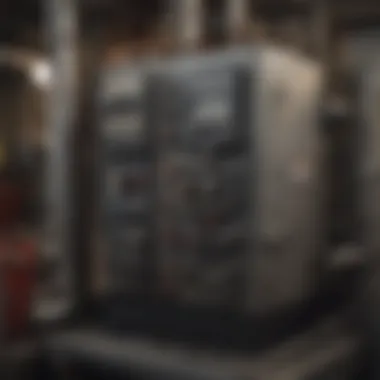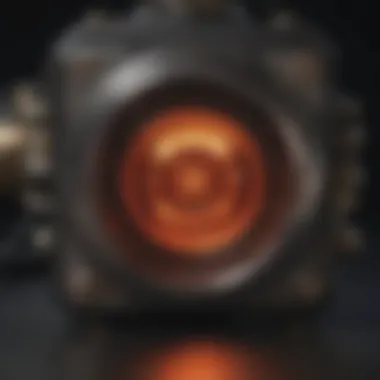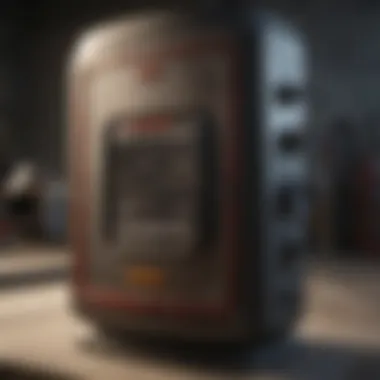Understanding Honeywell Furnace Pilot Systems


Intro
In modern heating systems, understanding the components that ensure efficiency and safety is critical. Honeywell furnace pilot systems are a significant part of this equation. They are primarily responsible for igniting the gas in furnace burners, making them crucial for safe operation. Homeowners and professionals alike should grasp their design, functionality, and common issues.
As a leader in the HVAC industry, Honeywell has developed pilot systems that prioritize reliability and maintenance ease. This article endeavors to unfold the complexities surrounding these systems. We will explore their importance, mechanisms, and some common challenges faced during their operation. Through a detailed examination, we aim to equip readers with valuable knowledge that enhances their understanding and aids in troubleshooting and maintenance practices.
Preamble to Honeywell Furnaces
In the realm of heating systems, Honeywell emerges as a prominent name, recognized for its innovation and reliability. Understanding Honeywell furnaces is crucial for anyone relying on effective heating solutions, particularly in residential or farming settings. The ability to grasp the mechanics behind these furnaces not only ensures efficient heating but also facilitates informed decisions regarding maintenance and troubleshooting.
Before diving into the specifics of Honeywell furnace pilot systems, it is beneficial to review the broader context of Honeywell as a brand and the variety of furnaces it offers. This foundation helps illuminate the significance of pilot systems within the heating landscape.
Overview of Honeywell as a Brand
Honeywell has established a distinguished presence in numerous industries, including home comfort, building automation, and aerospace. Founded in 1885, its commitment to innovation and quality is evident in its product range. The company prioritizes advanced technology and eco-friendliness, demonstrating a clear understanding of consumer needs and environmental considerations.
This brand is often synonymous with reliability. Its heating products are designed to endure the rigors of daily use. Many consumers prefer Honeywell furnaces for their durability and performance, making it a benchmark in the heating sector. When investing in a heating solution, recognizing Honeywell's reputation informs users of the likely quality and longevity of their purchase.
Types of Honeywell Furnaces
Honeywell manufactures various types of furnaces that cater to different heating needs and preferences. Here are some notable types:
- Gas Furnaces: These are among the most common in residential applications, utilizing natural gas for energy efficiency and affordability.
- Oil Furnaces: In some regions, oil furnaces may be preferred due to availability or specific heating requirements.
- Electric Furnaces: These provide an alternative for areas lacking access to gas lines, offering flexibility in installation.
- High-Efficiency Models: Honeywell's advancements include models designed for maximum efficiency, helping to reduce energy costs while maintaining warmth.
Understanding these various types sets the stage for comprehending the specific components and mechanisms at play in Honeywell furnace pilot systems. Each furnace may incorporate different technological features, but all share the essential need for reliable pilot systems to function optimally.
Understanding Pilot Systems
In the context of Honeywell furnaces, understanding pilot systems is crucial for both optimal performance and safety. The pilot system is a key component that ensures the user can effectively ignite the furnace, leading to a consistent and reliable source of heating. Grasping the intricacies of these systems can lead to better troubleshooting techniques and fewer malfunctions.
One of the fundamental elements of pilot systems is the pilot light itself. This small flame acts as a reliable ignition source for the main burners. If the pilot light goes out, the furnace cannot operate, which can result in uncomfortable conditions during cold seasons. Thus, maintaining the functionality of this element is essential for continual heating.
Moreover, recognizing how pilot systems integrate with larger furnace components can improve service approaches. A well-understood pilot system can lead to fewer service calls and reduced operational disruptions. This topic is not just about understanding one part, but rather how it harmonizes with the entire heating system—this connection ultimately contributes to energy efficiency and safety.
What is a Pilot Light?
A pilot light is a small flame used to ignite the gas burners in gas-powered furnaces. It is a continuous flame that burns constantly in the background and is essential for the ignition process of the furnace. The pilot light is usually located in proximity to the burner assembly, allowing it to activate automatically when the furnace demands heat.
It's important to note that not all pilot lights are alike. Some systems utilize a standing pilot light that remains on at all times, while others may employ intermittent pilot systems, which ignite only when needed. The choice of pilot light impacts the furnace's overall efficiency and safety, making it a vital aspect in furnace design.
Role of the Pilot Light in Furnaces
The role of the pilot light is fundamentally about ignition. When the thermostat signals the furnace to produce heat, the pilot light ignites the gas that flows into the burner system. This action generates the heat necessary to warm the air circulated within the home.
Key functions of the pilot light include:
- Ignition Source: It ensures that the gas burners ignite without delay.
- Safety Mechanism: The light helps prevent gas buildup in the event of malfunction, as it can only operate if there is a flame present.
- Indicator of System Health: A strong and steady flame indicates a functional system, while an out or weak flame signals potential issues.
Failure of the pilot light can result in the furnace shutting down, leading to concerns that go beyond mere discomfort. If professional servicing is required, it can avoid extensive damages and ensures that the heating system functions appropriately during the heating season.
"Understanding the pilot light's function is essential for any homeowner relying on a Honeywell furnace."


Components of a Honeywell Pilot System
Understanding the components of a Honeywell pilot system is crucial for efficient operation and maintenance of your furnace. Each component plays a pivotal role in the overall functionality and safety of the system. Familiarity with these elements allows homeowners and professionals alike to diagnose issues and perform effective troubleshooting.
Pilot Light Assembly
The pilot light assembly is the starting point for combustion within the furnace. It consists of a small flame that ignites the main burner when heating is required. The efficiency of this assembly directly impacts the furnace’s performance. A steady, blue flame indicates proper functioning. Any discrepancies in color, size, or presence often point to underlying issues. If the pilot light goes out, the furnace cannot heat, leading to unnecessary downtime.
Importance of Maintenance
- Regular Checks: Inspecting the pilot light assembly routinely helps ensure continuous operation.
- Cleaning: Dust and debris can obstruct the assembly, affecting the flame size and efficiency.
Thermocouple Functionality
The thermocouple is a safety device that detects whether the pilot light is lit. It generates a small voltage in response to the heat from the pilot flame. If the pilot light goes out, the thermocouple cools down and stops sending voltage to the gas valve. This action prevents gas from flowing, reducing the risk of dangerous gas buildup.
Characteristics of a Good Thermocouple
- Responsive: It should respond quickly to changes in temperature.
- Durable: Look for corrosion or damage as it can affect functionality.
Gas Valve Mechanism
The gas valve mechanism controls the flow of gas to the pilot light and main burners. It ensures that the correct amount of gas is released for safe ignition. A malfunctioning gas valve can lead to various issues, including gas leaks and inefficient heating.
Functions of the Gas Valve
- Regulation: Manages the flow of gas based on the system’s heating demands.
- Safety: Shuts off gas supply when the pilot light is extinguished or when there is an anomaly detected in the system.
"The interplay between these components defines the performance of the Honeywell furnace pilot system. A small fault in one can lead to larger issues down the line."
Common Issues with Honeywell Pilot Systems
Understanding common issues faced by Honeywell pilot systems is crucial for effective furnace operation. These problems can disrupt heating efficiency and safety, leading to discomfort in homes and potential hazards. Being aware of these issues enables homeowners and technicians to address them promptly. This section discusses the key problems, their implications, and how to mitigate them.
Pilot Light Going Out
A common issue with Honeywell pilot systems is the pilot light going out unexpectedly. This can result from several factors, including drafts, a malfunctioning thermocouple, or debris in the pilot light assembly. When the pilot light extinguishes, the furnace cannot heat the home effectively. If it goes out frequently, it can signal a larger, underlying problem that may require professional attention.
To troubleshoot this issue, first check if any airflow is affecting the pilot light. Closing nearby doors or windows may help. If the pilot light keeps going out, inspect the thermocouple for any signs of wear or damage. Replacing a faulty thermocouple is often a simple fix. Regular inspections can minimize occurrences of this issue.
Insufficient Flame Size
Another notable problem is the insufficient flame size of the pilot light. A weak flame can indicate a blockage in the pilot orifice or a decrease in gas pressure. This problem can lead to inefficient furnace operation and insufficient heating. A properly functioning pilot light should produce a strong, steady blue flame.
Homeowners should observe the flame regularly. If it appears yellow or flickering, immediate action is necessary. Cleaning the pilot assembly may restore proper functionality. In case of ongoing issues, checking the gas line for pressure problems is advisable. This will ensure adequate gas flow to the pilot and burner systems.
Gas Supply Interruptions
Gas supply interruptions can significantly hinder the performance of Honeywell pilot systems. These interruptions can arise from external factors like supply line issues or internal factors such as an obstructed gas valve. Without a consistent gas supply, the pilot light cannot remain lit, and the furnace cannot operate.
To address this issue, homeowners should verify that the gas supply is active. This may require checking the gas meter and ensuring all valves are open. If there is a suspicion of a supply issue, consulting with a gas company is wise. Regular maintenance can help mitigate supply disruption causes, ensuring smoother operations during colder months.
Regularly monitoring these common issues can prolong the lifespan of your Honeywell furnace and enhance overall performance.


Understanding these common issues is a vital part of managing Honeywell furnace pilot systems. Addressing these problems promptly can lead to more efficient heating and prevent potential hazards.
Troubleshooting Honeywell Furnace Pilot Lights
Troubleshooting Honeywell furnace pilot lights is a pivotal aspect of maintaining heating systems. Understanding how to diagnose and address issues can prevent more serious problems that could lead to costly repairs or unsafe conditions. Pilots serve as ignition sources for the burners in gas furnaces, meaning that if the pilot fails, the entire system can become ineffective. Thus, it is crucial for homeowners to be equipped with knowledge on this matter. The following sections detail initial diagnostics, steps to reignite the pilot, and how to assess the thermocouple. Each step contributes to ensuring that the heating system operates safely and efficiently.
Initial Diagnostics
When a pilot light is extinguished, the first step is to conduct initial diagnostics. This involves observing various indicators that can point to the underlying cause of the issue. Here are some areas to check:
- Visual Inspection: Check if the pilot light is out. Look for any discolored or weak flames if the pilot is lit.
- Gas Supply: Ensure that the gas supply to the furnace is turned on. A shut-off valve may have been closed unintentionally.
- Circuit Breaker: Examine the circuit breaker or fuse associated with the furnace. A tripped breaker or blown fuse can interrupt power to the gas valve.
In addition, check for any error codes displayed on the furnace control panel. Many Honeywell furnaces come equipped with diagnostic systems.
Steps to Reignite the Pilot
If the pilot light is out, follow these steps to reignite it:
- Turn Off the Gas: Start by turning the gas control knob to the "off" position and wait for about five minutes. This allows any residual gas to dissipate.
- Access the Pilot Light: Locate the pilot light assembly, typically found near the main burner.
- Set the Control Knob: Turn the gas control to the "pilot" setting. This allows gas to flow to the pilot light.
- Ignite the Pilot: Use a long lighter or match to ignite the pilot flame. Press down on the reset button while lighting the pilot, if applicable.
- Observe the Flame: After the pilot is lit, continue to hold the reset button for about 20 to 30 seconds to ensure the thermocouple heats up and maintains the gas flow.
- Set Back to "On": Once the flame is stable, turn the control knob from "pilot" to "on" to return the furnace to regular operation.
Following these steps usually resolves issues with the pilot light.
Assessing the Thermocouple
If the pilot light continues to go out or does not stay lit after following the reignition steps, it may indicate that the thermocouple has failed. The thermocouple is a safety device designed to detect the flame's presence. If it does not detect sufficient heat, it will close the gas valve to prevent gas leaks. Here are steps to assess the thermocouple:
- Check For Any Damage: Inspect the thermocouple for signs of physical damage. It should be intact and in good condition.
- Test Voltage Output: Use a multimeter to measure the voltage output of the thermocouple. Ideally, it should produce around 25 millivolts or more.
- Clean the Connection: Sometimes, dirt or corrosion can impair performance. Ensure that the connection point is clean and secure.
If problems persist despite these checks, replacing the thermocouple may be necessary to restore proper function to the pilot system.
Maintenance Practices for Honeywell Furnaces
Maintaining Honeywell furnaces is crucial for ensuring efficiency, safety, and longevity in operation. Regular upkeep minimizes the chances of unexpected failures and enhances energy efficiency, which translates into cost savings over time. Homeowners and professionals should recognize the benefits of conducting thorough maintenance on their pilot systems. This includes understanding how each aspect affects overall performance and why proactive measures are vital. With proper maintenance, the risk of significant issues diminishes, leading to a reliable heating solution.
Regular Pilot Inspection
Regularly inspecting the pilot light is essential for the consistent operation of Honeywell furnaces. This simple step helps to ensure that the pilot light ignites promptly and effectively every time. During inspection, you should check for a steady blue flame; any yellow or flickering flame might indicate problems with the gas supply or combustion efficiency. An inspection also allows you to clean the pilot assembly if necessary, which prevents blockages that could lead to performance issues. Additionally, confirming that the pilot light is properly positioned can avoid unnecessary interruptions in heating.
Clearing Dust and Debris
Dust and debris are common nuisances that can accumulate around the furnace, particularly in the pilot area. Regularly clearing this buildup is necessary to maintain optimal function. Dust can block airflow, causing overheating and inefficient combustion. It’s advisable to schedule seasonal cleanings to mitigate any potential problems. Use a soft brush or a vacuum with a nozzle extension to gently remove dirt. By keeping the area clean, you help ensure that the furnace performs well and extends its operational lifespan regardless of how often it is used during colder months.
Checking Gas Connections
Gas connections should be checked periodically for signs of leaks or damage. An intact and efficient gas connection is vital for not only performance but also for safety. To check the connections, visually inspect the lines for wear and listen for unusual sounds, such as hissing, which may indicate a leak. Any concerns should prompt immediate action, such as turning off the gas supply and contacting a professional. Ensuring proper connection reduces the risk of gas-related issues and supports the overall effectiveness of the Honeywell furnace.
Regular maintenance not only protects your investment but ensures a safe and warm home during those colder months.
Importance of Professional Servicing
Proper maintenance of Honeywell furnaces is essential for achieving efficient operation and prolonging the unit's lifespan. Regular professional servicing ensures that the system functions at optimal levels, minimizing the risk of unexpected failures. Professional technicians possess the specialized knowledge and tools necessary to address intricate issues within furnace pilot systems. Such expertise is crucial not only for maintaining performance but also for ensuring safety in the heating process.


When homeowners neglect to schedule routine maintenance, they expose themselves to several risks. Poorly maintained furnaces can lead to hazardous situations such as gas leaks or carbon monoxide buildup. Professional servicing mitigates these risks by allowing technicians to inspect critical components like the gas valve and thermocouple, ensuring everything is functioning correctly and safely.
The consideration of the complexity of modern heating systems further underscores the necessity for professional care. As Honeywell furnaces become equipped with advanced features, such as electronic ignition systems and smart thermostat integration, the technical demands for repairs and maintenance have increased. Individuals may misdiagnose issues, leading to incorrect fixes and additional problems.
Ultimately, investing in professional servicing is a proactive measure that can save homeowners considerable expenses in the long run.
When to Call a Professional
Knowing when to call a technician is essential for maintaining the furnace's health. Homeowners should consider seeking professional help in the following scenarios:
- The pilot light frequently goes out, even after attempting to reignite it.
- There are unusual noises during the furnace operation, which can indicate a mechanical issue.
- The furnace fails to produce the expected heat.
- There are signs of corrosion or leakage around the gas connections.
- The heating system is operating inefficiently, resulting in high energy bills.
If one of these warning signs arises, it is advisable to consult a professional. They can conduct a thorough inspection and offer solutions tailored to the specific issue.
Benefits of Regular Service
Regular servicing of a Honeywell furnace offers numerous advantages. Here are key benefits:
- Enhanced Efficiency: Routine inspections help identify issues that reduce efficiency. Fixing these problems can lead to optimal performance and lower utility costs.
- Prolonged Lifespan: With regular maintenance, the lifespan of the furnace can significantly extend, leading to fewer replacements over the years.
- Safety Assurance: Regular servicing reduces the likelihood of hazards, such as gas leaks and fire risks, ensuring the safety of the household.
- Improved Air Quality: A well-maintained furnace contributes to better indoor air quality, reducing health risks associated with dust, dirt, and allergens.
Advancements in Furnace Technology
As modern heating solutions evolve, the significance of advancements in furnace technology cannot be overstated. These improvements are crucial for enhancing efficiency, reducing energy consumption, and increasing safety in residential heating systems. By integrating newer technologies, Honeywell furnaces not only meet regulatory standards but also adapt to the evolving needs of users.
Electronic Ignition Systems
Honeywell has significantly embraced electronic ignition systems in recent years. This technology replaces traditional pilot lights with a more efficient method of starting the furnace. Electronic ignition systems ignite the burner directly using an electrical spark or hot surface instead of relying on a continuously burning pilot light. This system offers several advantages:
- Energy Savings: Electronic ignition uses less gas than conventional pilot lights, leading to lower energy costs over time.
- Environmental Impact: By consuming less fuel, electronic ignitions contribute to a reduction in greenhouse gas emissions.
- Safety: With electronic ignition, there is a decreased risk of gas buildup, which can occur if a pilot goes out and gas continues to flow.
Smart Thermostat Integration
The integration of smart thermostats into Honeywell furnaces represents a leap forward in home heating efficiency. Smart thermostats allow homeowners to control their heating remotely, either through smartphone apps or smart home systems. This capability offers numerous benefits:
- Customization: Users can tailor heating schedules based on occupancy and preferences, optimizing energy use.
- Learning Algorithms: Many smart thermostats learn user habits and automatically adjust settings for maximum efficiency.
- Real-time Monitoring: Homeowners can track energy usage patterns, which aids in identifying potential issues.
"Adopting advanced heating technologies not only enhances comfort but also leads to significant cost savings and environmental benefits in the long term."
Ending
The conclusion of this article encapsulates the significance of Honeywell furnace pilot systems in ensuring efficient and reliable heating solutions. As outlined throughout the previous sections, understanding these systems involves recognizing their key components, common issues, and maintenance practices. Knowledgeable users and professionals can enhance the performance and longevity of their heating equipment.
The intricate workings of pilot systems are foundational to the overall functionality of a furnace. Proper insight into elements like the pilot light assembly, thermocouple functionality, and gas valve mechanisms allows users to troubleshoot effectively. Homeowners who are well-versed in these aspects can often address minor issues on their own, which can save on repair costs and downtime.
Furthermore, the emphasis on regular maintenance cannot be overstated. Consistent checks and timely servicing can prevent larger issues, ensuring that furnaces operate safely and efficiently. This proactive approach can lead to improved energy efficiency, reduced utility bills, and longer equipment life.
Overall, this article serves as a critical guide for both homeowners and industry professionals, providing essential knowledge to navigate the complexities of Honeywell furnaces and their pilot systems.
Summary of Key Points
- Honeywell furnaces utilize pilot systems for ignition and operation.
- Key components include the pilot light and thermocouple.
- Regular maintenance and troubleshooting are crucial for optimal performance.
Future Considerations for Honeywell Furnaces
As technology advances, Honeywell continues to innovate in heating solutions. Future considerations for furnaces may include:
- Increased integration of smart technology for remote management and diagnostics.
- Enhanced safety features to prevent hazards associated with gas heating.
- Development of more energy-efficient systems to comply with environmental standards.
Understanding these future trends is essential for anyone involved in the heating industry, as it will guide purchasing decisions and maintenance practices. Staying informed about these advancements enables homeowners and professionals to make educated choices regarding their heating systems.



